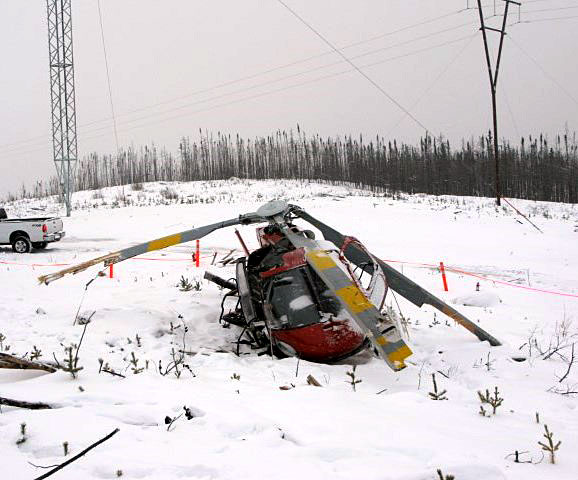Collision with terrain
Airspan Helicopters Ltd.
Eurocopter AS350 B2 (helicopter)
C-GJPW
Key Lake, Saskatchewan, 11 nm SE
The occurrence
The Airspan Helicopters Ltd. Eurocopter AS350 B2 (registration C-GJPW, serial number 4738), was conducting aerial work approximately 11 nautical miles southeast of Key Lake Airport, Saskatchewan. At approximately 1231 Central Standard Time, the helicopter began an uncommanded roll and rotation to the left, descended, and collided with the terrain. The pilot, who was the sole occupant, sustained serious injuries but was able to evacuate without assistance. The 406 MHz emergency locator transmitter activated on impact, and the signal was detected by the search-and-rescue satellite system. The helicopter sustained substantial damage. There was no post-impact fire.
Media materials
News release
Dynamic rollover led to loss of control and impact with the ground in the January 2015 helicopter accident in Key Lake, Saskatchewan
Read the news release
Deployment notice
TSB deploys a team of investigators to a helicopter accident in Key Lake, Saskatchewan
Winnipeg, Manitoba, 22 January 2015 - The Transportation Safety Board of Canada (TSB) is deploying a team of investigators to Key Lake, Saskatchewan, where a Eurocopter AS-350 helicopter was involved in an accident. The TSB will gather information and assess the occurrence.
Investigation information
Download high-resolution photos from the TSB Flickr page.
Class of investigation
This is a class 3 investigation. These investigations analyze a small number of safety issues, and may result in recommendations. Class 3 investigations are generally completed within 450 days. For more information, see the Policy on Occurrence Classification.
TSB investigation process
There are 3 phases to a TSB investigation
- Field phase: a team of investigators examines the occurrence site and wreckage, interviews witnesses and collects pertinent information.
- Examination and analysis phase: the TSB reviews pertinent records, tests components of the wreckage in the lab, determines the sequence of events and identifies safety deficiencies. When safety deficiencies are suspected or confirmed, the TSB advises the appropriate authority without waiting until publication of the final report.
- Report phase: a confidential draft report is approved by the Board and sent to persons and corporations who are directly concerned by the report. They then have the opportunity to dispute or correct information they believe to be incorrect. The Board considers all representations before approving the final report, which is subsequently released to the public.
For more information, see our Investigation process page.
The TSB is an independent agency that investigates air, marine, pipeline, and rail transportation occurrences. Its sole aim is the advancement of transportation safety. It is not the function of the Board to assign fault or determine civil or criminal liability.
